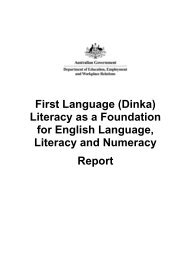Review - Department of Innovation, Industry, Science and Research
Review - Department of Innovation, Industry, Science and Research
Review - Department of Innovation, Industry, Science and Research
Create successful ePaper yourself
Turn your PDF publications into a flip-book with our unique Google optimized e-Paper software.
differentiated further. For example, for the pr<strong>of</strong>essional <strong>and</strong> pedagogical<br />
aptitude, the regulations mainly focus on general principles (such as<br />
legal conditions, involved persons <strong>and</strong> organisations), regulations for the<br />
planning <strong>of</strong> the training (such as the suitability <strong>of</strong> the training<br />
organisations, the collaboration with the vocational school for the<br />
theoretical phases within the dual system, etc.), the involvement during<br />
the recruiting phases for the trainees (including recruiting criteria,<br />
training contract, etc.), training on the job (such as practical support,<br />
controlling <strong>of</strong> learning success, etc.), assistance during the learning<br />
process (including cooperation with external organisations, considering<br />
cultural differences, etc.), training within a group (such as short<br />
presentations, training <strong>of</strong> team learning, etc.) <strong>and</strong> completing training<br />
(including preparing for examinations, generating certificates, etc.)<br />
Quality<br />
assurance<br />
approach<br />
There is not one dominant quality assurance approach in the initial training system.<br />
As described above, there are different bodies, training regulations <strong>and</strong> test processes<br />
that ensure quality.<br />
In the Germany’s VET system many approaches are applied. In cases when the<br />
Federal Employment Agency is financing VET courses, the providers need to be<br />
approved <strong>and</strong> they need to apply a systematic instrument for quality assurance <strong>and</strong><br />
quality development according to AZWV §8, Abs. 4.<br />
According to a national representative study 78 (2005) conducted by the Federal<br />
Institute for Vocational Education <strong>and</strong> Training, almost all providers <strong>of</strong> further<br />
education (98 per cent) 79 assure their quality in the one or other way. The most<br />
widely used quality assurance approach among providers in further education is selfevaluation<br />
(84 per cent), quality <strong>and</strong> approval seals (46 per cent), certificate <strong>of</strong> ISO<br />
9000ff (39 per cent), regional quality system (39 per cent), AZWV: approval <strong>of</strong> the<br />
federal employment agency (37 per cent), participation in competitions (26 per cent),<br />
EFQM (16 per cent), LQW (16 per cent) <strong>and</strong> others (12 per cent). Self-evaluation<br />
can be everything ranging from detailed quality assurance systems that are tailormade<br />
for specific circumstances <strong>of</strong> one provider to infrequently occurring surveys.<br />
Those quality assurance approaches that are more st<strong>and</strong>ardised <strong>and</strong> include external<br />
validation are less frequently applied. Interestingly, providers <strong>of</strong>ten combine two (82<br />
per cent), three (60 per cent) <strong>and</strong> sometimes even four (40 per cent) approaches.<br />
The concepts <strong>of</strong> quality assurance have regular intervals in which the quality is reassured.<br />
These intervals have to be followed by the training organisations otherwise<br />
the quality seal is taken away from them.<br />
The following concepts are the most frequently used st<strong>and</strong>ardised quality<br />
approaches:<br />
ISO 9000ff. (International Organisation for St<strong>and</strong>ardisation 80 )<br />
This approach is a collection <strong>of</strong> st<strong>and</strong>ards for quality management systems.<br />
This system was originally developed for the manufacturing industries <strong>and</strong> from the<br />
early 1990s was transferred to other branches. It is now also regarded as a valuable<br />
quality assurance certificate for VET providers.<br />
78 www.bibb.de/en/11920.htm<br />
79 Source <strong>of</strong> all the data provided in this paragraph: A. Krewerth/H. Kuwan: Weiterbildungsanbieter im<br />
"Qualitätslabyrinth" - Zur Situation der Anbieter und den Wirkungen von Weiterbildungstests. In:<br />
Berufsbildung in Wissenschaft und Praxis, Jahrgang 35 (2006), Heft 6, S. 28 - 33<br />
80 www.iso.org/iso/about/international_st<strong>and</strong>ardization_<strong>and</strong>_education.htm<br />
Comparisons <strong>of</strong> international quality assurance systems in vocational education <strong>and</strong> training Page 86 <strong>of</strong> 115
















